Tag: vines
The Agony of Dropping Fruit
This is only a guess, albeit a somewhat educated guess, but I suspect every vineyard worker has the same uneasy, guilty feeling the first time he drops fruit from a vine.
By dropping fruit, I mean walking through the vineyard, from one vine to the next, and cutting off perfectly good clusters of grapes and letting them fall to the ground. It seems wasteful, and when you see a cluster of nearly perfect grapes lying on the ground next to your feet, you feel like a butcher. But you have to remain focused and keep your eye on the prize.
“Think about the wine,” said Julien Durantie, the vineyard manager at DuCard Vineyards. Ah, yes, the wine. Don’t worry about the grapes on the ground that will soon rot and return to the soil to nurture future crops. Think ahead a year or more to the wine that will be made from the fruit that remains.
The idea behind dropping fruit is simple: the vine has only so much energy, and by reducing the number of clusters, you end up with a more concentrated juice and much better, much more intense wine. In a sense, this is a continuation of the process we’ve been engaged in throughout the growing season. Early on, we thinned out the shoots, leaving behind a smaller number of shoots that we hoped would produce high-quality grapes. As we moved through the season, pulling leaves to open up the canopy, we continued to remove suckers, laterals, and extra shoots that would deprive the vine of its vigor.
Removing suckers and thinning shoots was one thing. Clipping off beautiful clusters of berries that were turning into wine grapes, was much harder. I tried to keep my mind focused on the wine.
As was the case in many classes before, I found myself nearly paralyzed at the start, not quite remembering what I had been told, and staring at the vine, afraid to make the first cut. And so, I spent time separating out vines that had become tangled, pulling some laterals (which look like a small, separate leaf system), and considering whether to cut this clump or the next one. And finally, as always, I called Scott Eliff, the vineyard’s owner, or Julien, and begged for help.
We were working just at the onset of veraison, the time in which the berries change color. Here and there, we spotted a few cab franc grapes turning purple, but the vines we actually worked on were Viognier, Virginia’s signature white grape. (Actually, while the Virginia Wine Board has declared Viognier to be the Commonwealth’s Signature Grape, I prefer to think of it as the signature white. Cab Franc and Petit Verdot are my choices for reds.
In any event, a little bit of my heart lay on the ground with each cluster of grapes. And I was only the hired (well, volunteer) help. I can’t imagine how agonizing it is for the owner of the vineyard to drop fruit, knowing he or she is reducing the vineyard’s yield significantly with each clip of the pruning shears.
Fortunately, this is one kind of heartache that can be cured by opening and tasting a bottle of wine that has benefitted from the “Green Harvest” of dropping fruit. Wine is often said to be made in the vineyard, and the best is made by vineyards like DuCard that are willing to sacrifice quantity for quality.
The Potato Leafhopper Saga, Part II
Continuing the Potato Leaf Hopper saga, which strictly speaking hasn’t yet risen to the level of a saga, it looks like we’re making some progress. We evaluated our Nelson County vines over the weekend and are reasonably happy with what we saw. The new leaves looked healthy and disease free, and the vine seems to be growing nicely (well, with the exception of one vine, which appears to be the runt of the litter).
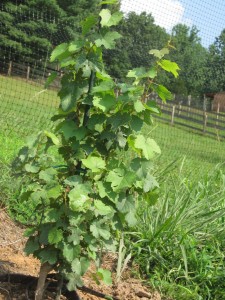
- This Cab Franc vine is growing slowly, but it appears healthy. No holes in the leaves from Leafhoppers, and good color.
Most important, the Potato Leafhoppers appear to have all but vanished. Two weekends ago, they were gone. Last weekend, we found one or two, and removed them by hand. We’ll check again next weekend, but for now, the Vineyard Goddess is resting easy, and we doubt we’ll need to hit the vines with another dose of pesticide.
Now, I’m sure some of you are wondering if I was being a bit overly dramatic. You’re thinking, yeah, the Potato Leafhopper is probably some kind of mean little insect, Bob, but in a world full of pests, it’s pretty small fry. It’s not like Donald Trump parked himself in your vineyard and let the property go to seed. (Actually, that would be the vineyard some 30 minutes down the road.)
But trust me, the Potato Leafhopper is a pest to be taken seriously. Consider this statement from the Compendium of Grape Diseases, an authoritative guide to vineyard problems: “Few insects have plagued grape growers during the last century more than leafhoppers.”
According to the Compendium, the potato leafhopper breeds in the Gulf Coast states over the winter, then grow in number through March and April before migrating northward, distributing themselves over most of the U.S. The leafhopper harms grapes “by mechanically injuring and blocking vascular tissue, by injecting toxic enzymatic secretions, or by a combination of both mechanisms.” You ever see Trump blocking any vascular tissue?
In any event, it appeared that the Leafhopper was doing considerable damage to the vineyard, and we were ready to go to war with it. With luck, we might have put that pest behind us, which will free us up to deal with the myriad other problems that plague vineyards. Like overly acidic soil. Or Downey Mildew. And someday, maybe, birds, foxes and bees. Stay tuned for the next report from the front.
The Vineyard Goddess and the Potato Leafhopper
The Vineyard Goddess was not happy.
Our Nelson County vineyard was looking decidedly unhealthy. The leaves on the vines were pale, and they were full of holes. My wife, the Vineyard Goddess, spent hours inspecting the vines, looking through books, and searching the Internet for answers. Finally, she decided to email a photo of the not-so-healthy leaves to a Virginia Tech grape pathologist.
Virginia Tech’s Agricultural Research and Extension Center is a wonderful resource for Virginia Viticulturists, and they could not be more helpful. Within a few hours, she had an answer. It was most likely an insect that was doing the damage.
Although we hadn’t seen any bugs in the vicinity, the Vineyard Goddess decided to stake out the seven vines until she found what she was looking for. She didn’t have to wait long. There, on our Mammolo Toscano – I could almost hear her shriek, “not the Mammolo!” – were two tiny green bugs. They moved fast, but not as fast as the Vineyard Goddess.
Pinching one between thumb and forefinger, she carried it back to the house, combed through our viticulture books as well as the Internet, and made a positive ID. It was a Potato Leafhopper. We had never heard of a Potato Leafhopper, and had no idea why it had given up on potatoes and turned to our vineyard for nutrition. But it had.
It turns out that the Potato Leafhopper not only likes to munch on grape vine leaves, but it produces a toxic saliva that can dry up the leaves and mimic drought conditions. That explained a lot, including the curled leaves on our vines
VG immediately dusted the vines with a cure-all pesticide, and we both crossed our fingers.
Stay tuned for the next report from the front lines of our battle with this pest.
Grow Tubes Reconsidered
Those of you who have been following this blog know that I recently offered some unkind words about grow tubes, which many vineyards use to nurse along young vines. My criticism was based partly on research and partly on personal experience.
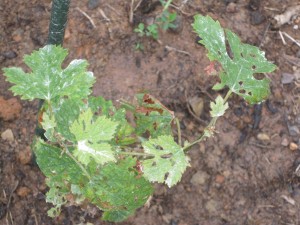
The Nelson vineyard vines, (do seven vines make a vineyard?) after removal of the tubes, leave a lot to be desired.
As I recounted, we had been told in one vineyard management class to use grow tubes, and then, in another, to get them off the vines post-haste. We had two points of reference.
First, our Fairfax vines, which were planted and nurtured without benefit of grow tubes, are doing spectacularly well. It’s possible, of course, that we’re just kidding ourselves, and the growth we’re seeing is the result of overly vigorous vines. While vigor is no
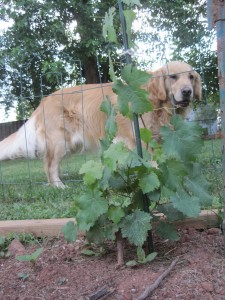
The Fairfax vines (all seven of them) seem to be flourishing, perhaps because Phoenix, the Vineyard Dog, stands guard over them.
doubt welcomed by farmers raising soy or corn, overly aggressive vines produce low-quality fruit. We want the vigor to go to the grapes, not the vines.
Be that as it may, the Fairfax vines appear strong and healthy. By contrast, the vines on our Nelson County property, which were planted with the protective shelter of grow tubes, seem, well, frail. They have holes in the leaves. Lots of holes. And scrawny, brown-looking leaves. Not what we had hoped for at all.
We wondered if the grow tubes were the problem. One of our friends who manages a large vineyard, urged us to take the tubes off, warning that, in this heat, all we were doing was baking the vines. We did some investigating on our own, and much of the research we looked at suggested that the only reason for using grow tubes is to facilitate the use of herbicides – the tubes protect the vine while Roundup or something like that clears vegetation out of the rows of vines.
So, we swore of grow tubes, and I wrote an angry rant about them. I haven’t changed my mind, but in fairness, I have to say that it appears that almost everyone else in this business loves grow tubes. Continue Reading–>
Goodbye to Grow Tubes Forever!
Apparently there’s no agreed-upon rule book for viticulture.
When we planted Cab Franc vines on our Nelson County property, we followed the advice offered at a class on that very subject at the Piedmont Virginia Community College (great curriculum –the best available in Virginia today), and covered them with grow tubes. We
did the same for the two Mammolo Tuscano vines which we had received as a gift from Gabriele Rausse, one of the founding fathers of the Virginia wine industry and the instructor for a class on grafting.
At another class over the weekend, we were told, in no uncertain terms, to take them off. Sigh.
After doing a lot of overnight research, we decided that the grow tubes – ours are the so-called “Blue X,” which consist of a blue plastic insert and a soft-skin translucent blue sleeve – had to go. But it was kind of a close call.
A lot of the research we looked at suggested that while grow tubes provide a hot-house environment that jump starts the growth of the vines in their early months, they also prevent the vines from achieving their potential. The focus of the first two years is developing a strong trunk and root system. As Julien, the vineyard manager at DuCard Vineyards, told me, you must be willing to do the work, and to do it when it needs to be done. And you must be willing to be patient. The tubes, he added, rushed the process and created a hot-house that could cook the vines to death in the 90-plus degree weather we’ve been having.
My wife, the Vineyard Goddess (and future Vineyard Manager), took Julien’s words to heart and found a good deal of evidence to support the anti-grow tube proposition. Continue Reading–>
The Vines Emerge into the Sunlight!
- After two weeks, this Cab Franc vine emerges from the earth
- Three Cab Franc in the foreground, two Mammolo in the background
At long last — actually, it was only two weeks — the Cab Franc vines emerged from the soil. When we planted the vines, the graft union — the large swollen area where the root stock and the scion met — was hilled over, which is to say, we made a mound of dirt to cover the graft union. The graft union very quickly sent shoots up, and so this weekend, we removed the dirt that we had mounded over the vine, sprayed for all the diseases that Virginia humidity and (especially) rain can bring, and then place the blue-x grow tubes over the vines.
In this gallery, you see on the ends (I was having a problem with the software, and it was just easier to keep two of the same picture on the ends) a picture of three of the five Cab Franc vines, plus two of the Mammolo Tuscano that we planted earlier, the Mammolos being a gift from Gabrielle Rausse, one of Virginia’s great winemakers. In the middle, is a picture of the vine that emerged from the graft union that was still buried.
As Gabrielle said to us in a class, “the vine is so smart.” It definitely knows what to do. A small cutting from the vine can be made to both bud at one end — giving rise to a vine that will bear fruit — and take root at the other. Unfortunately, Vitis Vinifera vines from Europe cannnot grow on their own roots here in the U.S. They will die from Phylloxera (which nearly destroyed the entire wine industry in Europe in the 19th century) or some other North American disease. To survive, the Vinifera vine must be grafted onto American rootstock. The rootstock my vines are grafted onto is known as 101-14.
With luck, we’ll be making wine from these vines in three short years!
Bob

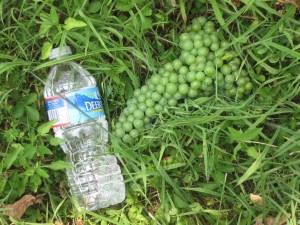
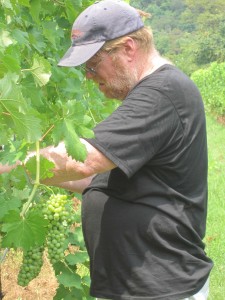
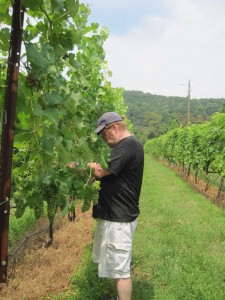
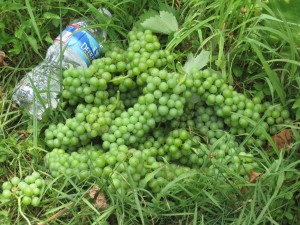
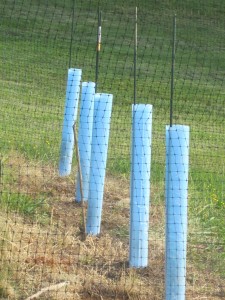
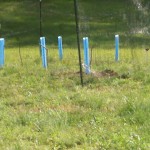
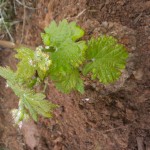
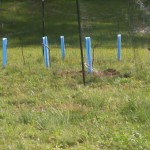


Recent Comments